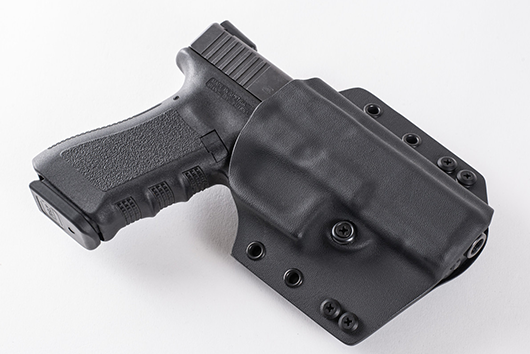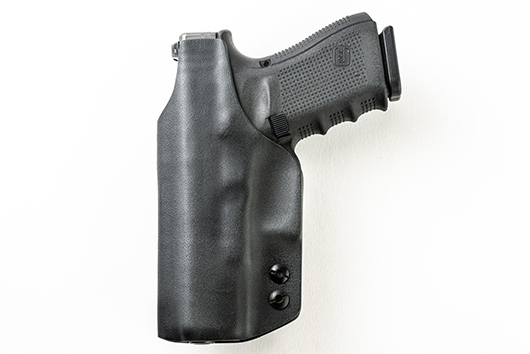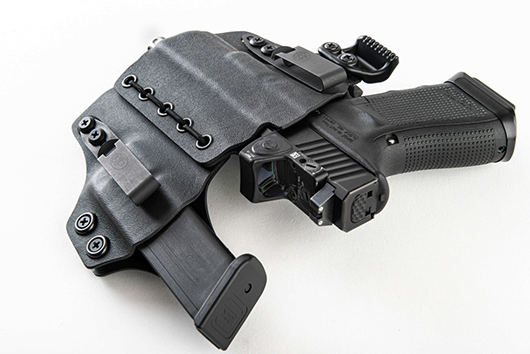Glock 17 vs. 19: Which is the Best for Concealed Carry?
Nov 17th 2023

Although Glock is one of the world’s most well-known firearm manufacturers, it is almost exclusively known for producing handguns. The Glock 17 and Glock 19 are the Austrian gunmaker’s oldest and most famous semi-automatic pistol designs, first introduced over three decades ago.
If you own or are considering either one for concealed carry, you may wonder which of these two Glocks is the best for the job. Compare the Glock 17 vs. 19, review each pistol’s specifications, understand their similarities and differences, and determine which model is the best for concealed-carrying applications.
Pistol Specifications: Glock 17 vs. 19
Both Glock handguns are similar in look and design and even share many parts. However, a closer look at their specifications can help you understand their differences and how they might perform as concealed-carry pistols.

Glock 17
The Glock 17 was the Austrian gunmaker’s very first pistol model. The company’s founder, Gaston Glock, introduced the first-generation G17 in 1982. The G17 was initially designed to meet the requirements of the Austrian Army, which wanted a new combat pistol.
Despite lacking prior experience in firearm design, he was a skilled engineer with expertise in synthetic polymers. Leveraging his knowledge and consulting with a team of prominent military, police, and civilian experts, he designed what he believed to be the optimal compact pistol.
The resulting pistol, the Glock 17, outperformed all other competing models and was adopted by the Austrian Army, where it was designated Pistole 80 (P80). Today, the latest iteration of the G17 is the Generation 5 model. While it integrates many modern technologies and advances in firearm design, the foundational concept remains consistent.
The Glock 17 was, and still is, a full-size combat pistol suited for military, police, and lawful civilian use. The pistol’s key characteristics, which have remained unchanged since 1982, are as follows:
- 9x19mm chambering
- 17-round double-stack magazine
- 4.49-inch barrel
- Lightweight polymer frame and parts, giving it an overall weight of less than 25 ounces with an empty magazine inserted
- Minimal controls and no manual safety lever
- Glock Safe-Action system and trigger-mounted safety mechanism

Glock 19
The Glock 19 was the third pistol the Austrian gun manufacturer designed, after the fully-automatic Glock 18. It was the first model designated as a “Compact,” which eventually became its own sub-family of Glock pistols.
The Glock 19 was introduced in 1988 as a smaller alternative to the full-sized Glock 17. It was initially intended with law enforcement users in mind, especially U.S. police departments. While the concept of a compact version of a full-sized pistol was not new, Glock’s approach was unique.
The G19 was not a shorter version of the Glock 17; it was designed to maintain as much parts compatibility as possible, minimizing the need for bespoke components. Even though the resulting pistol is smaller and lighter, it maintains accuracy and possesses a sufficiently high capacity suitable for combat and duty applications.
Shooters can swap the Glock 19’s standard 15-round magazine for a Glock 17’s 17-round mag with no modification. All G19s are fully compatible with G17 magazines; the only impact is sticking out of the bottom of the frame by about half an inch.
Like the G17, the Glock 19’s key characteristics have remained unchanged since the Gen 1 model from 1988. They are as follows:
- 9x19mm chambering
- 15-round double-stack magazine
- 4.01-inch barrel
- Approximately 0.75” shorter in length and 0.43” shorter in height compared to the G17
- Fully compatible with full-size Glock 17 magazines
- Shares the same Safe-Action system, controls, trigger, safety, and many internal parts with the G17
Comparing the Glock 17 vs. 19 for Concealed Carry
At first glance and based on the specifications alone, it can be tempting to think that the Glock 19 is the best choice. Many shooters consider the G19 a “Goldilocks gun:” large enough for duty use yet small enough for concealed carry.
However, examining more closely how well the G17 performs compared to the G19 as a concealed-carry handgun may surprise you. Here’s a breakdown of how each model compares in three key criteria: Controls and ergonomics, shooting comfort, and ease of concealment.
Controls and Ergonomics
Due to their shared basic design, the Glock 17 and the Glock 19 have a similar ergonomic profile and identical essential controls. When comparing a G17 and a G19 of the same generation, the grip angle, grip texture, and trigger pull weight are identical. For instance, Glock rates Gen 5 versions of both handguns at 26 Newtons or about 5.85 pounds-force.
Even more subtle features, such as the dimensions of the slide serrations or the sights, are identical between handguns. If you are skilled with one, you can likely shoot and operate the other with equal proficiency.
The only major difference between the G17 and G19 regarding controls and ergonomics is the grip size. The Glock 19 is a compact handgun with a shorter grip than its full-sized counterpart. Generation 5 versions have a mildly flared magazine well near the bottom of the grip, which can impact grip and comfort.
If you have large hands, gripping the G19 may cause the flare to dig into your pinky finger. In contrast, the full-sized grip of the G17 is unlikely to cause specific discomfort to most shooters because it offers more space for all your fingers, allowing a proper, full grip.
Shooting Comfort and Recoil
Regularly practicing with your concealed carry pistol is essential for any shooter. Consistent practice ensures you are familiar and confident with your firearm, contributing to the accuracy required in self-defense.
Comfort during shooting and managing recoil are crucial aspects, as most shooters are less motivated to practice with a pistol that causes discomfort.
Although one is a full-size pistol and the other is its compact version, both handguns have comparable shooting comfort and recoil characteristics. Assuming the same brand of standard-pressure ammunition is used, both Glocks are relatively soft-shooting handguns generating mild, easily controlled recoil.
The primary differences come down to physics. The Glock 19 Gen 5 weighs about 23.63 oz. with an empty magazine and about 30 oz. fully loaded with 15 rounds. In contrast, the Glock 17 Gen 5 is just under 25 oz. empty and approximately 33.33 oz. with a loaded 17-round magazine.
While these may feel like minor differences, the G17’s extra weight lets it absorb recoil more effectively, which can help you shoot more quickly and accurately. These differences will become more pronounced the more proficient you become with either handgun.
Ease of Concealment
Generally, full-size pistols are harder to conceal. While you can do it, you must adjust your conceal-carry setup to minimize printing as much as possible. Your body type also plays a role in determining what is easier and more comfortable to carry. For instance, larger and taller shooters may have fewer problems concealing full-size pistols like the G17.
Based on specifications alone, the Glock 17 should be harder to conceal than its compact counterpart. It has a longer slide and barrel, a taller frame, and is overall heavier than the Glock 19. The G19’s dimensions are also frequently hailed as just the right size, offering the right balance of capacity, comfort, and dimensions.
The ease of concealing either handgun depends on the carry style you prefer.
Concealing the Glock 19
The Glock 19 may be more advantageous for you if:
- You primarily carry inside the waistband (IWB) and want to minimize your IWB holster’s profile as much as possible
- You carry in the strong-side hip position or FBI style (behind the hip with a forward cant)
- You prefer to carry a lighter gun
Traditional conceal-carry methods, such as strong-side IWB, place your handgun on one side of your body. When concealment is a priority, you want to ensure your gun sticks out as little as possible. The G19’s lower weight and smaller dimensions play in your favor for such applications.
Concealing the Glock 17
You may prefer to conceal-carry the Glock 17 if:
- You carry appendix inside the waistband (AIWB), especially in a dedicated AIWB holster
- You conceal-carry with an OWB holster
- You are relatively tall or have a larger body type
Choosing a suitable concealment holster and opting for the correct carry position are crucial factors in effectively hiding the G17. For example, carrying inside the waistband (IWB) in the appendix position allows you to carry the firearm at the front of your body rather than the side. This positioning uses the broader side of your body for concealment, facilitating the effective hiding of a full-size pistol.
OWB holsters are also better suited for full-size handguns. This is because you don’t have to worry about carrying a large handgun on the inside of your waistband, which can be uncomfortable or increase the risk of printing.
While carrying OWB for concealment has its own drawbacks (e.g., needing to wear the right clothes to cover the gun and holster), it is one of the most accessible solutions for conceal-carrying a G17.
Shop Quality Concealment Holsters For Your Glock at Incognito Concealment
While there are some differences between the Glock 17 vs. the 19, both are excellent choices for concealed-carry. The gun that performs the best for you depends on your preferences, your concealment holster, and your carry position.
Keep your pistol properly hidden from view with an Incognito Concealment holster. We carry a large selection of low-profile IWB and OWB Kydex holsters for the Glock 17, Glock 19, and hundreds of other models.











